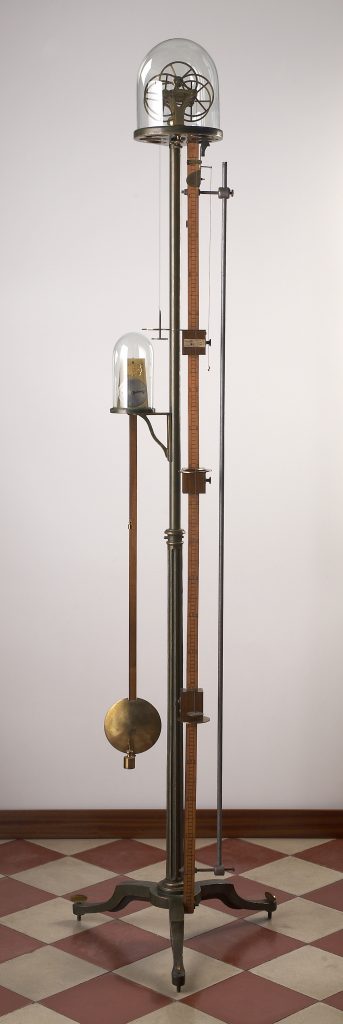32-M MACCHINA DI ATWOOD – 32M ATWOOD MACHINE

Legno, metallo, ghisa, ottone, vetro
Base: 590 x 590; h. 2100
Dell’Acqua – Milano
3/4 XIX secolo
Lo strumento, ideato dal matematico inglese George Atwood (1746 – 1807), serve per verificare le leggi di caduta dei gravi sia con moto uniformemente accelerato sia con moto uniforme, misurando in maniera relativamente semplice i tempi di caduta da una determinata altezza.
Un sostegno in ghisa montato su un treppiede munito di viti regolabili termina con una piattaforma forata, sulla quale è montata una puleggia mobilissima, il cui asse orizzontale, per ridurre gli attriti, poggia sull’intersezione di quattro ruote; il meccanismo è protetto da una campana di vetro. Lungo l’asta verticale sono montati un regolo lineare graduato in legno – sul quale possono essere applicati un piattello e due cerchi in ottone – e un pendolo contasecondi.
Nella puleggia scorre un filo sottile, alle cui estremità si trovano due piattelli portapesi.
All’apparecchio sono annessi pesi diversi sui quali è inciso il corrispondente valore.
Il dispositivo è firmato ed è stato acquistato nel 1860 – 61.
Riferimenti: LPSAS, CCLXXXV, Catalogo metodico, p.10, n.22
Wood, metal, cast iron, brass, glass
Base: 590 x 590; h. 2100
Dell’Acqua – Milan
3/4 XIX century
The instrument, invented by the English mathematician George Atwood (1746-1807), was used to verify the laws of falling bodies with either uniformly accelerated and uniform motion, by measuring in a relatively simple way the free-fall time from a given height.
A cast-iron support fitted on a tripod with adjustable screws ends in a perforated platform on which a highly mobile pulley is attached. Its horizontal axis rests on the intersection of four wheels in order to reduce friction; the mechanism is protected by a glass bell. A graduated wooden linear rule – on which a brass plate and two brass circles can be fitted – and a pendulum counter are mounted along the vertical rod.
A thin wire, at the ends of which two weight plates are placed, runs through the pulley.Various weights can be attached to the device, on which the corresponding value is engraved.
The device is signed and was purchased in 1860/1861.
References: LPSAS, CCLXXXV, Methodical Catalogue, p.10, n.22.